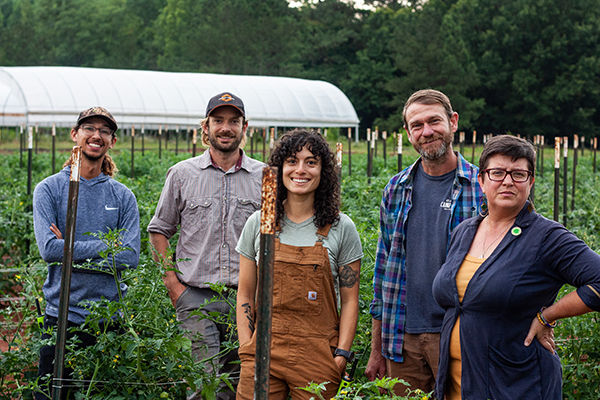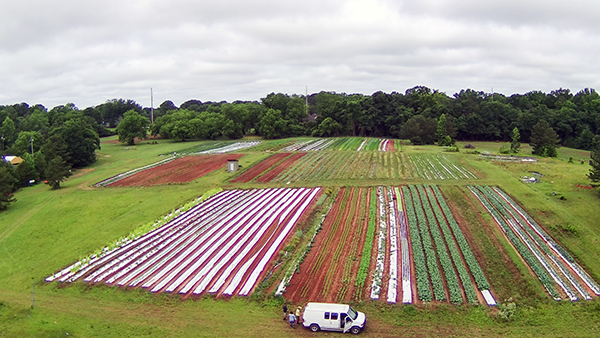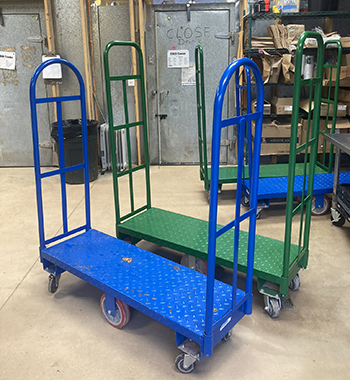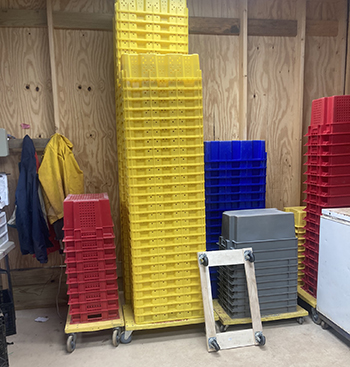When I pulled into Love is Love Cooperative Farm late one afternoon in February, several vehicles sat in the parking area and people worked busily in all areas of the spanning property. I found Judith Winfrey, one of the founding worker-owners and a long-time friend, preparing for a meeting. She connected me with Joe Reynolds, calling him on the walkie-talkies everyone carries. Joe and Judith started Love is Love Farm in 2008.
 Love is Love Cooperative Farm worker-owner group photo. From left: Demetrius Milling, Russell Honderd, Monica Ponce, Joe Reynolds and Judith Winfrey. Photo by Joe Spiccia.
Love is Love Cooperative Farm worker-owner group photo. From left: Demetrius Milling, Russell Honderd, Monica Ponce, Joe Reynolds and Judith Winfrey. Photo by Joe Spiccia.
After leasing for years, they decided they wanted to own the land they farmed. At the time of my visit, I was in the trenches of my own lease negotiations and felt this myself. In 2018, they teamed up with Monica Ponce, Russell Honderd, and Demetrius Milling to form a new, collaborative farm.
As someone who has run a farm for twenty years, along with my partner, just the two of us shouldering all of the burdens, balanced with our responsibilities as parents, the cooperative farming structure fascinates me. The thought of sharing responsibilities among several people and welcoming in new, younger farmers, I find appealing.
Joe showed me around their expansive fields. Pointing to a field in cover crop, he explained that funds from a California-based non-profit, piloting their program in Georgia, helped purchase a grain drill. Zero Foodprint takes 1 percent of participating restaurant sales and converts that money into grants for farmers growing carbon sequestering cover crops. I later emailed to ask if Alabama farmers could participate, but unfortunately not yet. However it is available in other states such as Colorado.
 Love Is Love Farm from above. Photo by Addison Hill.
Love Is Love Farm from above. Photo by Addison Hill.
The grain drill was purchased used, same as with much of their other equipment, but there is plenty new as well. Currently, they have over 10 acres planted in cover crops. As we walked, he explained more about how they financed starting their operation here in Mansfield.
“We are in a land program called The Working Farms Fund, based out of The Conservation Fund,” Joe said. “They identify growers and farm land at risk of development and provide leases to applicant farmers. We lease the farm for cash rent over a five-year period while they work to put the land in an agricultural conservation easement, protecting the land and lowering the price tag of the land for us at the sale of the property. They also provide technical support and some capital to make the farm workable — wells, deer fence, home repairs.”
Raising capital to start a farm is always a challenge. At Love is Love, they found a way to use their greatest resource, community, to finance starting their business. Following suggestions from the Georgia Cooperative Development Center, they were able to set a unique system for individuals to invest. They used a law entitled the Georgia Securities Act. It allows citizens of Georgia to invest in businesses within the state through Georgia’s Secretary of State.
 The AZS Rinse Conveyor is a game changer when it comes to washing produce and even totes.
The AZS Rinse Conveyor is a game changer when it comes to washing produce and even totes.
First, they registered the amount they wanted to raise ($850,000) and then created a ledger, listing investors and investment amounts. Judith was able to draw on her experience running start-ups to create the framework. An attorney helped develop disclosure and share agreements, as well as do any necessary accredited investor verification required for investments over $10,000.
Investors receive a dividend during profitable years, a farm credit in non-profitable ones, and there is a buyback strategy that begins 10 years after the investment. Worker-owners retain full control (no ownership shares were offered). There is also an annual celebration and presentation that all investors are invited to and they send out an investor newsletter and annual report. Through this process, they were able to raise $817,000 from 106 individual investors, including all five worker-owners.
As we made our way to the back of the fields, multiple high tunnels stood mid-assembly. All five were found used, three different models, all lacking instructions and requiring a height modification to enable fitting their tractors inside. A friend of Joe’s who helped construct their greenhouses was also helping on the tunnel construction, enabling the farmers to continue to focus on growing.
Over the years, Judith and Joe cultivated a strong, committed community. When they reach out for help, there is always at least one person willing to volunteer. Their CSA administrator, once a volunteer, now works around 30 hours a week for the farm. Beyond the structure of the worker-owners, Love is Love demonstrates how members and customers can also be collaborators.
Circling around, passing by more fields lined with rows of winter crops, we ended up at greenhouses at the entrance to the farm where we started.
Inside the two large Atlas Snow Arch greenhouses, it was warm and smelled of soil and growing plants. It took two months to assemble them, required a boom lift, and the wiring alone cost $10,000. That said, they were already filling both in early February, so it was well worth the investment of time and money.
Later, Russell relayed the story of a hard freeze, that required moving hundreds of little pepper plants, already in pots, into Joe and Judith’s home on the property. Many of the plants suffered in the short time transferring them and did not survive. This experience alone, he says, makes the greenhouses worth it.
Plant sales have become a major outlet for Love is Love. Not only do they sell to home growers, but also to farmers, an area they identified for potential growth. Monica was seeding over 200 flats of green cabbage for a farmer the day I visited.
The on-farm plant sale in the spring is more than just an exchange, it is an event. There are food vendors, music, workshops, and educational sessions. They also host a large plant sale in the fall and attend several farmers markets in the weeks surrounding these sales, which is the only time the farm attends markets.
Plants are sold in Fertil Pots from Johnny’s Seeds for $4/each or $85 for a pack of 21. Their top sellers are Sungold cherry tomatoes, sweet basil, nasturtiums, Martha Washington tomatoes, Belstar Broccoli, flat leaf parsley, Petite marigolds and Lacinato kale.
In the washing and packing station, the totes were neatly stacked upside down on rolling platforms the same size as the totes. Everything was on wheels. Why lift or haul when you can simply roll? Joe demonstrated the ‘bin-in-a-bin’ system they use for harvest in the field, where one bin is designated to be on the ground and harvest bins are placed on top. This means the harvest bins never touch the soil and remain clean.
 U-boat carts help reduce the amount of carrying heavy bins.
U-boat carts help reduce the amount of carrying heavy bins.
Though the farm is not GAP certified, in the planning stages they did put systems into place to make it easy to become certified if and when they decide to do so. Clearly, much time, effort, and thought went into creating an efficient and orderly space where a bulk of the work load on a farm occurs.
One piece of equipment I have been seeing and hearing a lot about lately is the AZS Rinse Conveyer. Joe and Russell both say it has been a game changer. It rinses produce from the top and bottom as it moves down a conveyor belt, and can be adjusted for belt speed and water pressure to accommodate different types of produce. Not only is it used for washing produce, but they also send totes through, saving cleanup time at the end of the day.
As the sun began to set and the day was winding down, I stood around the tractors with Joe, Monica, and Demetrius as they talked about what had been accomplished that day and plans for the following day, the camaraderie and shared purpose rich between them. The conversation shifted to profitability, a tough one for all farmers. We wish it weren’t at the forefront of our minds, but it has to be in order to continue.
 For the Bin-in-a-bin system, certain colors of bins are used only for ground contact, so the color-coded produce bins never touch the ground.
For the Bin-in-a-bin system, certain colors of bins are used only for ground contact, so the color-coded produce bins never touch the ground.
I brought up the difficulties I have tracking labor costs across a variety of crops and a variety of people doing the labor. Joe mentioned a program through Oregon Tilth created to help farmers figure out labor costs. It is called Know Your Cost to Grow. I am currently time tracking tomatoes.
I could have talked with them all evening and well into the night. They graciously invited me to, but I know what the end of the day on a farm feels like with another one right behind. We said goodbye and as I drove away I wondered, could cooperative farming be the most viable path for farms in the future?
I followed up my visit months later with a remote conversation. All of the worker-owners generously shared their time on a busy day in June.
“Can you tell me more about the teams and how that works?” I asked.
Each worker-owner is on at least two teams, they told me, with one as the lead. Teams include Greenhouse, Field, Harvest, Wash/Pack, Flowers, and Marketing. A sidebar discussion on the difference between a team and a committee came up.
“Is HR a team or a committee?” Monica asked, consulting the group. “And what about Facilities?”
They alternate working on weekends, each person typically getting two days off per week, as well as two weeks of vacation. There are ‘blackout dates’ when everyone needs to be at the farm and the two weeks is “use it or lose it,” no carryover into the following year.
Another follow-up question I had was about the CSA add-ons they offer, which are significant: peanut butter, cheese, rice, bread, milk, meat, eggs. These partnerships are with producers they have built relationships with. The topic of add-ons comes up a lot with my partner and I regarding our own CSA. My position is that it would require a large amount of time, managing, sourcing, and packing. Joe says much of that work is done on the front end and systems are in place to ensure everything runs smoothly during the distribution weeks. They seem to like it and their customers definitely do.
It is still early days for the cooperative farm, a period of significant growth. They mention adding a third heated greenhouse already and breaking ground, beginning to plant even, at the second location they have down the road. At the time of formation, thought was given to a path for allowing new worker-owners to join. When I followed up on the specifics, Demetrius stressed that they want to wait until at least year five, once they feel settled, before adding anyone new to the core group. Monica adds they are in unanimous agreement that anyone interested would have to work on the farm for at least two years first. And there is a buy-in, but it is very affordable.
I couldn’t help but ask about if they recommend this model. There was a pause as everyone considered the question and then they all had something to say.
“It requires a lot of patience.”
“Anyone can do it, if they are open to communicate.”
“You have to come with insight and self-awareness.”
“Be prepared to be right and be wrong.”
“You really have to trust everyone,” Demetrius adds, explaining how he knows each of his collaborators is very adept at his or her job. He never doubts them. This is a key component of success for a cooperative farm.
Words like space, compassion, mistakes, and once again, trust. It takes a special group of people to be able to work together in this way, with horizontal management. I, myself, admire it and hope to see more of it in the future.
Margaret Ann Snow is co-owner and operator of Snow’s Bend Farm.
